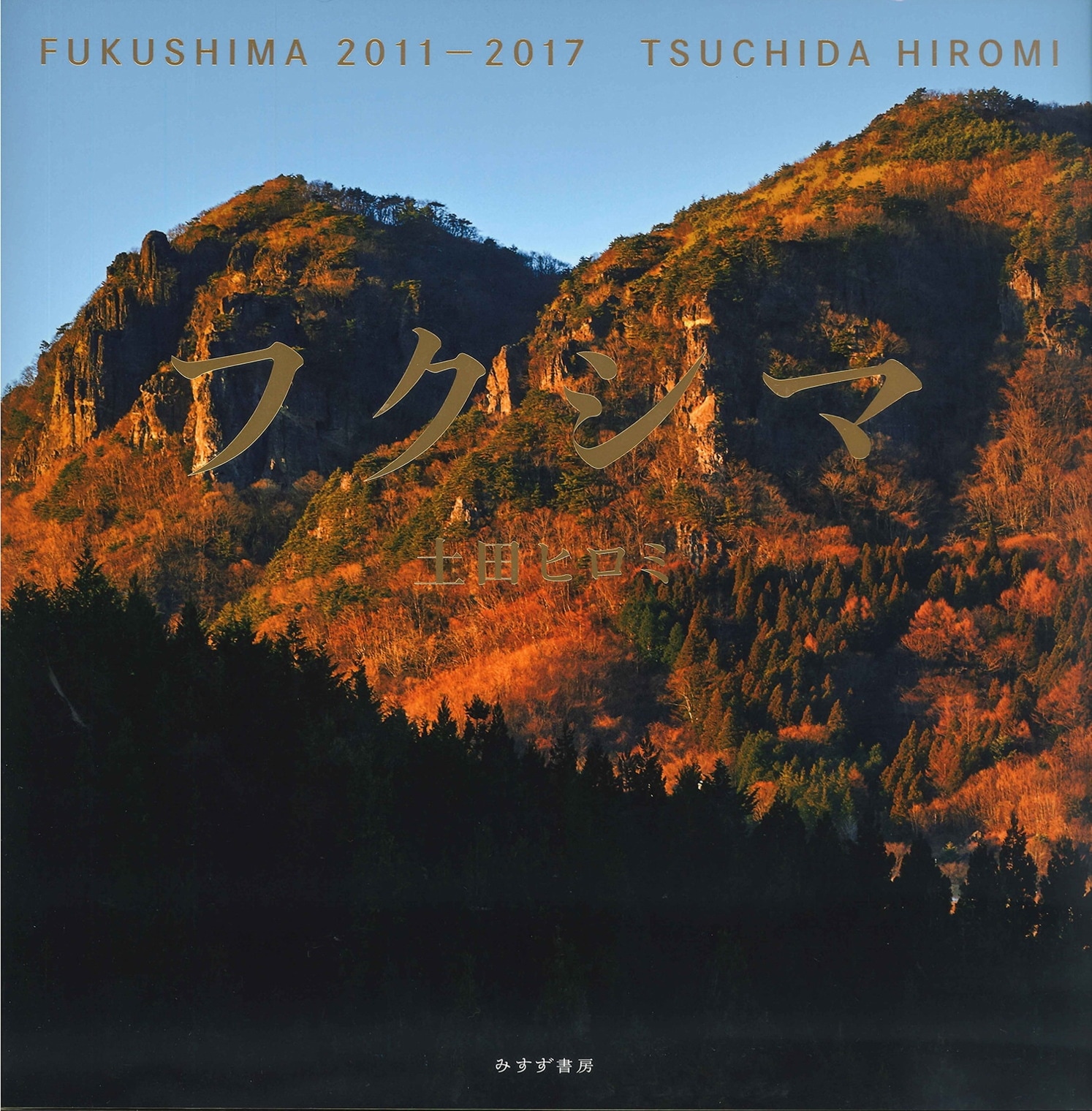フクシマ 2011-2017
FUKUSHIMA 2011-2017

| 判型 | A4変型 |
|---|---|
| 頁数 | 196頁 |
| 定価 | 13,200円 (本体:12,000円) |
| ISBN | 978-4-622-08669-7 |
| Cコード | C0072 |
| 発行日 | 2018年1月25日 |
| 備考 | 在庫僅少 |

FUKUSHIMA 2011-2017

| 判型 | A4変型 |
|---|---|
| 頁数 | 196頁 |
| 定価 | 13,200円 (本体:12,000円) |
| ISBN | 978-4-622-08669-7 |
| Cコード | C0072 |
| 発行日 | 2018年1月25日 |
| 備考 | 在庫僅少 |

福島の風景の多くは、長い時間をかけて人の手が作りだしてきた里山である。あれほど美しかった福島の自然。四季に移ろう風景から人が退避せざるをえない事態が生じた。
やがて除染作業が進み、黒いフレコンバッグが山と積まれ始めた。
風景が徐々に変わっていく。とてつもない何かが、この地に生じている。
高度な文明がもたらした福島第一原子力発電所事故。自然と人間の共生が崩壊していく現場の記録には、予兆として、人類の未来が写っているのかもしれない。
* 撮影行:120回
* 撮影区域:いわき市・伊達市・相馬市・南相馬市・田村市・川俣町・楢葉町・富岡町・浪江町・双葉町・飯舘村・葛尾村・川内村
* 撮影した5万点から190点を精選
* ドローン使用
* 写真説明・地図・エッセイ付
* 『はだしのゲン』翻訳者アラン・グリースン氏による英訳を付す [Bilingual Edition]
「土田ヒロミが福島でなくフクシマとしたのは、これまで40年にわたって広島ではなくヒロシマを撮ってきたからだ。人類史上のこれからもどこにでも起こりうる出来事として語りつぎたいという思いが込められている。……福島に、複雑怪奇だといいたくなる変化がじわじわ進行している」
(木下直之・東京大学大学院教授・芸術資源論 本書収載「この地に生じたとてつもない何か」より)
「机の上で、20キロ、30キロと、避難指示の円を地図に描いて拡大してみた。線上に家、学校、商店、田畑、谷川、森林、神社……などが理不尽な風景としてたち現れてきて、そこで起きている異常を思った。当事者の理不尽を共有できるような表現を目指さなくてはならないのだ……美しい山里の風景を撮っていたはずが、突然、汚染物の山が立ちはだかるという事態を記録しなければならなくなった。……未来に向かってレンズを向けているような感覚に襲われもした。眼前の風景が十年後、二十年後、どのようになっているのだろうか?」
(土田ヒロミ「フクシマの風景を撮る」)
[Synopsis]
On March 11, 2011, a massive earthquake struck northeastern Japan, triggering an accident comparable to the Chernobyl disaster at the Fukushima Daiichi Nuclear Power Plant, only 260 kilometers north of Tokyo. Thousands of people were forced to evacuate, and their communities were declared unsafe for habitation. This book introduces a series of fixed-point photographs taken in radiation-contaminated areas of Fukushima Prefecture by Hiromi Tsuchida, known worldwide for his work tracing the postwar changes in Hiroshima, a city destroyed by another form of the same nuclear energy that has devastated Fukushima.
The contaminated zones of Fukushima were inhabited by people who had cultivated and coexisted with nature for many generations. The region is a rolling land of rice paddies, pastures, farm ponds, mountainous landscapes out of a sumi-ink painting, rivers and seacoasts rich with fish, and cherry trees that people gathered under in the spring. Still standing are the houses families used to live in, the gardens they tended, their schools, amusement parks, and shopping districts.
After the nuclear accident, people vanished from this landscape and the natural beauty of Fukushima began to undergo a transformation. The decontamination process scraped the topsoil off vast swathes of land to a uniform depth of five centimeters, along with the trees and plants growing there. Because permanent disposal sites have yet to be decided, black container bags full of this waste continue to pile up throughout the area. A bizarre and complex reality persists with no resolution in sight. Tsuchida resorted to the use of drones to film this eerie landscape from above.
This photo collection is a chronicle of the breakdown of the symbiotic relationship between human beings and nature. The scenes it depicts may presage the future of a civilization that has been relentless in its pursuit of material wealth at all costs. Through these artistically stunning photographs one can hear the lament of the land they portray.
The book includes commentaries, maps, and latitude/longitude data on the photographs in both English and Japanese.
. . . more ˃
[About the Photographer]
Tsuchida Hiromi was born in 1939 in Fukui Prefecture. After graduating from the School of Engineering at the University of Fukui, he worked for POLA Cosmetics, Inc., then resigned to go freelance.
He taught from 1971 to 1996 at the Tokyo College of Photography and from 2000 to 2013 at the Osaka University of Arts, where he continues to teach as a part-time lecturer. He also serves on several exhibition and award selection committees. His photographic work addresses the transformations undergone by Japan in series about Hiroshima, which he has photographed for four decades since 1975, the economic boom and bubble eras, and local festivals and customs. His award-winning books include Autistic Space (1971 Taiyo Award), Hiroshima 1945-1978 (1978 Ina Nobuo Award), Hiroshima (1984 Photographic Society of Japan Award), and Tsuchida Hiromi’s Nippon (2008 Domon Ken Award). Major publications include Zokushin: Gods of the Earth (1976), Counting Grains of Sand (1990), and Berlin (2011). His works are found in the collections of museums worldwide, among them the Tokyo Metropolitan Museum of Photography, The National Museum of Modern Art, Tokyo, The Museum of Modern Art, New York, Pompidou Centre, the National Gallery of Canada, and the Tate Modern.
Title: Fukushima 2011-2017
Author: Hiromi Tsuchida
ISBN: 978-4622086697
Pages: 196
Size: 11.9 x 11.9 in / 29.8 x 29.8 cm
Category: Photography, nuclear accident, Fukushima, earthquake
Publisher: Misuzu Shobo, Tokyo, 2018
. . . more ˃
(写真の一部をご紹介しています)